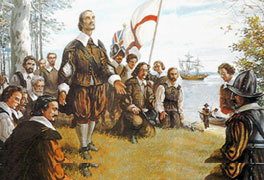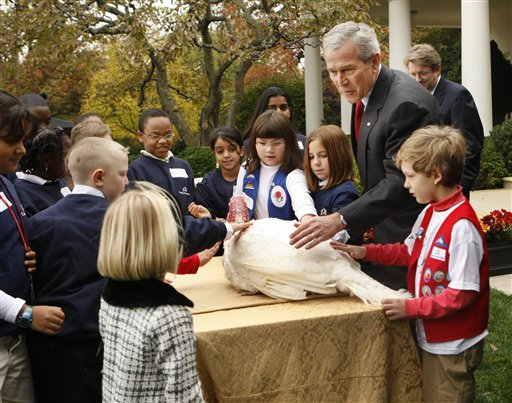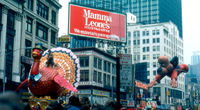Introduction
The purpose of current essay is to provide the analysis of Thanksgiving Day’s historical cultural patterns of celebration in the past and now. The Thanksgiving Day rites, customs and options of celebration will be discussed in relation to ethnographic features of a given territory and its people. New York Macy’s parade held during Thanksgiving Day was chosen as the primary object of analysis.
Besides this current research provides the description of the role Thanksgiving plays in shaping cultural and religious identity of people and reflecting deeper social layers of life. Current paper is subdivided into several parts. The analysis of Thanksgiving Day in historical perspective is provided in the first place with detecting changes that occurred in the way it is celebrated. Secondly, the contemporary Thanksgiving Day cultural patterns are analyzed with a special emphasis on values, food, family relations and places of celebration. Thirdly, a comprehensive analysis of Thanksgiving Day in the formation of people’s social, religious and cultural identity is provided with a particular emphasis on the role of religion, social experience, the relations within family and the formation of the intrinsic worldview and values. The analysis of ethnographic cultural patterns as they are presented in New York cultural patterns of Thanksgiving Day celebration are embedded in the discussion of identity formation. To top it all these descriptions are made drawing on a relevant material of modern Thanksgiving Day celebrations. If all these stages of research are completed we hope that a comprehensive account of Thanksgiving Day in terms of its role in shaping people social and cultural identities would be provided.
History of Thanksgiving Day in the United States

The history of Thanksgiving presents an interest to popular writers, historians, sociologists and anthropologists. The story of Thanksgiving Day celebrating began with Pilgrims, the newcomers to America who organized the fest for Wampanoag people and themselves on October 1621 (Meyers, p. 114). After the United States gained their independence three presidents prior to Abraham Lincoln such as Washington, Adams and Madison issued proclamations of Thanksgiving as a national holiday. For a long period of time Thanksgiving was popular only in the states of New England and to a much lesser degree in mid-Atlantic states. Besides this it should be mentioned that Thanksgiving was traditionally popular in Texas. The first settlers in new colonies which celebrated Thanksgiving regarded it as a ‘thanksgiving to God’ for their successful arrival to new lands.
Historical documents prove inherently religious nature of early Thanksgiving celebration: ‘We ordaine that the day of our ships arrival at the place assigned for plantacon in the land of Virginia shall be yearly and perpetually keept holy as a day of thanksgiving to Almighty God’ (Santino, p. 167).
The celebration of Thanksgiving in the colonies of England during 17-th was expressed in the form of thanksgiving to God for the harvest collected. During 18-th century many British colonies observed separately the celebration of Thanksgiving Day. Unlike Thanksgiving Day that can now be met in different regions of the United States it was not marked by enormous amount of food and drinking but was spared for prayers and the fasting.
The reasons for celebrating Thanksgiving were not settled until the end of the 18-th century and such occasions as good crop, military victory (as in case with Saratoga in 1777) were chosen as the pretext for celebration. Until the First National Announcement of the Thanksgiving by Continental Congress in 1977 it was celebrated quite sporadically without any single cultural pattern.
Abraham Lincoln finally transformed Thanksgiving from the canonic religious patterns to civic religion celebration of American nationhood, values and ideals. As Bellah claims, ‘Thanksgiving postulates America being chosen by the divine providence to fulfill the mission of justice and freedom’ (Bellah, 175).
Hence, it is American nationalism that deeply shaped the celebration of the Thanksgiving after Lincoln.

The role of Thanksgiving in developing patriotism and feeling of common destiny partly explains the fact that modern school teachers and educators using this holiday for the incorporation of immigrant children to the American culture (though not many mothers could allow themselves to roast the turkey which cost quite much).
The celebration of modern Thanksgiving is also a political matter (see Image 2). Presidents beginning from Harry Truman pardon live turkey every year and it lives the rest of life in the peaceful farm (Appelbaum, p. 156).
Changing patterns of Thanksgiving Day celebration
With the industrial revolution and the development of secular modern society Thanksgiving Day significantly lost its religious connotations (Appelbaum, 56). The celebration of this holiday transformed into ‘domestic occasion’ using Pleck’s term (Pleck, p. 775). It was connected with a growing value of time and individualization of social relations.
The domestic occasions became scheduled events when the relatives living far away could come back to their homes and breadwinners of the family could spent more time with their children and wives. In his analysis of domestic patterns of celebration Schmidt comes to the conclusion that the luxury gifts presented during Thanksgiving Day is the central element of its becoming a domestic holiday (Schmidt, p. 54).
The modern time met Thanksgiving with a ban of so-called fantasticals, a tradition of begging on a Thanksgiving Day. It was announced as being immoral and was claimed to develop beggar consciousness among poor children. It also goes in line with a trend of this holiday domestication. These changes and the description of Thanksgiving customs as we know them now will be presented in the next section of this essay.
Thanksgiving Day in modern conditions
One of the central elements of modern Thanksgiving Day is dinner, a tradition which is presented in a homogeneous way through all states and regions in the United States (Linton, p. 87). The Thanksgiving dinner features turkey which plays a crucial role in celebration. In fact, using turkey in Thanksgiving dinner is an ‘invented custom’ using Hobsbawm famous concept.
Due to the preparation of roast turkey Thanksgiving Day is often called as Turkey Day. Among other dishes traditionally associated with Thanksgiving dinner notwithstanding the location of celebration are mashed potatoes, stuffing, cranberry sauce, sweet potatoes, vegetables, maize and often pumpkin pie. Many communities such as New York City have its annual food drives which purpose is to collect non-perishable food and canned food and deliver it to the poor (Schmidt, p. 157).
As the majority of families and friends gather together on Thanksgiving Day this holiday is the busiest travel period in the United States. Students in schools and colleges have four-day weekends in school. Most of government and business workers are also given paid weekends (News release, 2007).
Thanksgiving is also widely celebrated in bars, restaurants and clubs, hence it is quite busy day for them. There is no denying the importance of the fact that modern Thanksgiving Day gave rise to different festivals and parades which are organized in different American cities (later more attention will be paid to Macy’s parade in New Your City).
During Macy parade a large procession goes from West side of Manhattan to Macy store which is on Herald square. This parade includes various floats with the specific themes, scenes from various Broadway performances, different cartoon characters and celebrities etc. Macy’s parade signifies the beginning of Christmas days.
Thanksgiving Day parades are also held in other cities such Boscov’s parade in Philadelphia, America’s Hometown Parade in Plymouth, parades in Houston, McDonald’s Thanksgiving Parades in Chicago etc.
Modern patterns of Thanksgiving Day celebration are also characterized with Thanksgiving Day football competitions and games. The Intercollegiate Football Organization first held the first football championship devoted to Thanksgiving Day in 1876. Today more than 40.000 college and high school teams and different athletic clubs are playing this game on Thanksgiving Day (Schmidt, 1997).
Thanksgiving Day and identity formation: celebrations and New York Macy’s parade.
The Macy’s parade first organized in New York in 1924 is a symbol of Thanksgiving’s commercialization which is an important factor of this holiday impact on people’s identity formation. As Nissenbaum claims ‘Thanksgiving was a minor gift-giving occasion in the early nineteenth century’ (Nissenbaum, 214). People usually bought each other such presents as Bible. Only in the beginning of the 20-th century situation significantly changed with more shops offering Thanksgiving presents and gifts. The secularization of the holiday led to mass culture elements appearing in its celebration.
This is particularly true of Macy’s Thanksgiving parade in New York which is not associated with the origins of Thanksgiving but rather with Hollywood and mass culture images which appear in it. Thanksgiving becomes less of a religious holiday than a holiday when extensive consumption of various goods is welcomed. Commercial goods which were originally designed for Christmas and Valentine’s day are now sold for the Thanksgiving Day. They include various paper goods (depicting Pilgrims or Turkey), greeting cards, flowers, candies etc. Besides this allocating Thanksgiving ads on TV, radio and newspaper is very widespread today considerably affecting the formation of people’s identity. The Thanksgiving slogans penetrated in the advertisement of cigarettes. For instance, Camel commercial stated: “Camel are the cigarettes one should be thankful for” (Kammen, 210)

Considering this background information Macy’s parade can be described as a benchmark in developing of Thanksgiving Day cultural patterns in New York as departments stores initiated this event as a beginning of Christmas shopping season (see Image 3).
The connection between Thanksgiving and Christmas during Macy’s parade is evident as Santa Claus appears in its end symbolizing the shower of gifts that children will soon receive. When Macy’s parade first appeared it began competing with other entertainments in New York such as football games. Representing the change of holiday nature from religious to secular it also caused a wave of critiques from national and religious organizations which claimed that Macy’s parade spoils cultural traditions of American people.
Thanksgiving day and family formation
Community celebrations of Thanksgiving Day which were characteristic of this holiday from the time when it was first celebrated were replaced in the beginning of the 20-th century with private celebration in family circle. These changes account to significant secularization of Thanksgiving, its transformation into the family domestic occasion of middle class. As Pleck (1999) suggests, ‘The domestic occasion was a culturally dominant form, practiced at first mainly by the upper classes and middle classes, which spread throughout the society in the twentieth century’.
As Schmidt (1997) argues the celebration of Thanksgiving in family was a crucial catalyst of developing middle-class consumerist ideology and perception of the holiday. From then on it was associated with a crucial role of woman-homemaker organizing tasty dinner for the family members. Hence, modern Thanksgiving plays an important role in strengthening ties among family members and developing middle-class ideology in the family as Thanksgiving lost its religious connotations.
Forming religious experience
Notwithstanding the fact that Thanksgiving Day is losing its religious grounds, many religious families and organization still use it as a means of developing religious worldview in people. As far as 1789 American President Washington described Thanksgiving as a holiday that fosters ‘civil and religious liberty’, ‘useful knowledge’ and is an evidence of God’s ‘kind care’ and ‘his providence’ (Pleck, 779). This understanding of Thanksgiving Day is still wide-spread in American religious communities and organizations. They offer certain services and various events on Thanksgiving themes during holidays. In many homes there exists a long-standing tradition of saying grace before Thanksgiving dinner (Appelbaum, 136). Grace is a prayer which is said before and after dinner in order to express belief and appreciation of God, to ask blessing or sometimes to express the wish of dedication.
The grace process may be led by the host or hostess or sometimes each person may contribute his own words of thanks and blessing. Hence, it should be noted that Thanksgiving Day still continues to play a crucial role in shaping religious identity.
Shaping social experience
Thanksgiving Day also plays an important role in shaping social and national experience of Americans. Such scholars as Hobsbawm describe this holiday as ‘invented tradition’ that is a cultural pattern expressing the desire of modern people ‘to structure at least some parts of social life within it [their modern world] as unchanging and invariant.”(Hobsbawm, p. 10)
Social experience is shaped also as Thanksgiving Day becomes increasingly associated with starting shopping holidays when large amounts of consumer goods are sold and bought. There is no denying the importance of the fact that this plays an important role in social experience as children from poor families observe that they can’t buy such things as others buy. Besides this Thanksgiving Day forms national consciousness as teachers tell students about the history of the holiday, democratic ideals in which it is embedded. Education provides children with cultural set of values, principles and images such as flag, Pilgrim, Santa etc.
Conclusion
To sum it up, as current research has shown Thanksgiving Day is an important holiday that considerably transformed during its history. Initially it was sporadic religious holiday which then transformed into the symbol of patriotism and national building and finally now is increasingly becoming the product of commercial society and mass culture. It played and continues to play a crucial role in the formation of cultural, religious, family and social experiences and identity which was analyzed at length in current research.
References
- 1619 Thanksgiving at Berkeley Hundred in Virginia. Web.
- Appelbaum, Diana Karter. Thanksgiving: An American Holiday, An American History. New York: McGraw Hill, 1984
- Bush pardons turkey, 2007, Web.
- Bellah, Robert. “Civil Religion in America,” in Robert Bellah, ed., Beyond Belief: Essays on Religion in a Post-Traditional World. New York, 1970.
- Hobsbawm, Eric. “Introduction: Inventing Traditions,” in Eric Hobsbawm and Terence Ranger, eds., The Invention of Tradition, Cambridge: Cambridge University Press, 1983.
- Kammen, Michael. Mystic Chords of Memory: The Transformation of Tradition in American Culture. New York, 1991.
- Linton, Ralph and Adele. We Gather Together: The Story of Thanksgiving. New York, 1949.
- Love, DeLoss William, Jr. The Fast and Thanksgiving Days of New England. Cambridge, MA, 1985
- Macy’s parade procession. 2007. Web.
- Meyers, Robert J. Celebrations: The Complete Book of American Holidays. Garden City, NY, 1972.
- New Release. Thanksgiving Holiday Leave Reaches New High; Turkey Stages a Comeback as Employer Holiday Gift., 2007.
- Nissenbaum, Stephen. The Battle for Christmas. New York, McGraw Hill,1996
- Pleck, Elizabeth. “The Making of the Domestic Occasion: The History of Thanksgiving in the United States.” Journal of Social History 32.4 (1999): 773-799.
- Santino, Jack. All Around the Year: Holidays and Celebrations in American Life. Urbana, Illinois, 1994.
- Schmidt, Leigh Eric. Consumer Rites: The Buying and Selling of American Holidays Princeton, NJ: Princeton University Press, 1997